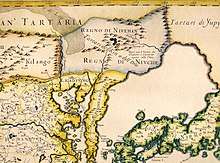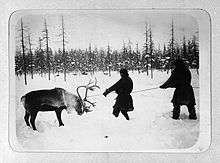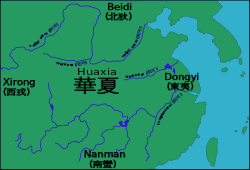Jurchen people
The Jurchen (Manchu: ᠵᡠᡧᡝᠨ Jušen, IPA: [ʤuʃən]; Chinese: 女真, Nǚzhēn, [nỳ.ʈʂə́n]) is a term used to collectively describe a number of East Asian Tungusic-speaking peoples who lived in the northeast of China, later known as Manchuria, before the 18th century. They are largely continuous with the Manchus of later history. Of obscure origins, different Jurchen groups lived as hunter-gatherers, pastoralist nomads, or sedentary agriculturists. Generally lacking a central authority, and having little communication with each other, many Jurchen groups fell under the influence of neighbouring dynasties, their chiefs paying tribute and holding nominal posts as effectively hereditary commanders of border guards.[4]
| Jurchen people | |||||||||
| Chinese name | |||||||||
|---|---|---|---|---|---|---|---|---|---|
| Chinese | 女真 | ||||||||
| Traditional Chinese | 女眞 (variant) | ||||||||
| |||||||||
| Korean name | |||||||||
| Hangul | |||||||||
| |||||||||
| Russian name | |||||||||
| Russian | Чжурчжэни | ||||||||
| Romanization | Tzshurtzhehnie | ||||||||
| Khitan name | |||||||||
| Khitan | dʒuuldʒi (女直)[2] | ||||||||
| Mongolian name | |||||||||
| Mongolian | Зүрчид, Зөрчид, Жүрчид Zu’rqid, Zo’rqid, Ju’rqid[3] | ||||||||
| Middle Chinese name | |||||||||
| Middle Chinese | /ɳɨʌX/ /t͡ɕiɪn/ | ||||||||
Chinese officials of the Ming dynasty (1368-1644) classified them into three groups, reflecting relative proximity to China:
- Jianzhou (Chinese: 建州) Jurchens, some of whom were mixed with Korean and Chinese populations, lived in the proximity of the Mudan river, the Changbai mountains, and Liaodong. They were noted as able to sew clothes similar to the Chinese, and lived by hunting and fishing, sedentary agriculture, and trading in pearls and ginseng.
- Haixi (Chinese: 海西) Jurchens, named after the Haixi or Songhua river, included several populous and independent tribes, largely divided between nomadic pastoralists in the west and sedentary agriculturalists in the east. They were the Jurchens most strongly influenced by the Mongols.
- Yeren (Chinese: 野人, lit. 'Wild People'), a term sometimes used by Chinese and Korean commentators to refer to all Jurchens. It more specifically referred to the inhabitants of the sparsely populated north of Manchuria beyond the Liao and Songhua river valleys, supporting themselves by hunting, fishing, pig farming, and some migratory agriculture[4]. Many "Yeren Jurchens", like the Nivkh (speaking a language isolate), Negidai, Nanai, Oroqen and many Evenks, are today considered distinct ethnic groups.
The Jurchens are chiefly known for producing the Jin (1115–1234) and Qing (1616/1636-1912) conquest dynasties on the Chinese territory. The latter dynasty, originally calling itself the Later Jin, was founded by a Jianzhou commander, Nurhaci (r. 1616–26), who unified most Jurchen tribes, incorporated their entire population into hereditary military regiments known as the Eight Banners, and patronized the creation of an alphabet for their language based on the Mongolian script. The term Manchu, already in official use by the Later Jin at that time[5], was in 1635 decreed to be the sole acceptable name for that people.
Name
The name Jurchen is derived from a long line of other variations of the same name.
The initial Khitan form of the name was said to be Lüzhen. The variant Nrjo-tsyin (now Nüzhen, whence English Nurchen) appeared in the 10th century under the Liao dynasty.[6] The Jurchens were also interchangeably known as the Nrjo-drik (now Nüzhi). This is traditionally explained as an effect of the Chinese naming taboo, with the character 真 being removed after the 1031 enthronement of Zhigu, Emperor Xingzong of Liao, because it appeared in the sinified form of his personal name.[6] Aisin-Gioro Ulhicun, however, argues that this was a later folk etymology and the original reason was uncertainty among dialects regarding the name's final -n.[7]
Jurchen is an anglicization of Jurčen,[3][8] an attempted reconstruction of this unattested original form of the native name,[9] which has been transcribed into Middle Chinese as Trjuwk-li-tsyin (竹里真)[lower-alpha 1] and into Khitan small script as Julisen.[7] The ethnonyms Sushen (Old Chinese: */siwk-[d]i[n]-s/) and Jizhen (稷真, Old Chinese: */tsək-ti[n]/)[10] recorded in geographical works like the Classic of Mountains and Seas and the Book of Wei are possibly cognates.[11] It was the source of Fra Mauro's Zorça[8] and Marco Polo's Ciorcia,[12] reflecting the Persian form of their name.[8] Vajda considers that the Jurchens' name probably derives from the Tungusic words for "reindeer people" and is cognate with the names of the Orochs of Khabarovsk Province and the Oroks of Sakhalin.[13] ("Horse Tungus" and "Reindeer Tungus" are still the primary divisions among the Tungusic cultures.)[14]
Janhunen argues that these records already reflect the Classical Mongolian plural form of the name, recorded in the Secret History as J̌ürčät,[9] and further reconstructed as *Jörcid,[12] The modern Mongolian form is Jürčid[3] whose medial -r- does not appear in the later Jurchen Jucen[12] or Jušen (Jurúna: ![]()
Appearance
According to William of Rubruck, the Jurchens were "swarthy like Spaniards."[17]
Sin Chung-il notes that during his visit to Fe Ala in the late 16th century that all those who served Nurhaci were uniform in their dress and hairstyle. They all shaved a portion of their scalp and kept the remaining hair in a long plaited braid. All men wore leather boots, breeches, and tunics.[18]
History
Prehistory and antiquity
When the Jurchens first entered Chinese records in 748, they inhabited the forests and river valleys of the land which is now divided between China's Heilongjiang Province and Russia's Primorsky Krai province. In earlier records, this area was known as the home of the Sushen (c. 1100 BC), the Yilou (around AD 200), the Wuji (c. 500), and the Mohe (c. 700).[19] Scholarship since the Qing period traces the origin of the Jurchens to the "Wanyen tribe of the Mohos" around Mt Xiaobai, or to the Heishui or Blackwater Mohe.[20], and some sources stress the continuity between these earlier peoples with the Jurchen[21] but this remains conjectural.[22]
The tentative ancestors of the Jurchens, the Tungusic Mohe tribes, were subjects of the multi-ethnic kingdom of Balhae. The Mohe enjoyed eating pork, practiced pig farming extensively, and were mainly sedentary. They used both pig and dog skins for coats. They were predominantly farmers and grew soybean, wheat, millet, and rice in addition to hunting.[23] Like all Tungus people, the Mohe practiced slavery. Horses were rare in the region they inhabited until the 10th century under the domination of the Khitans. The Mohe rode reindeer.[24]
Jin dynasty
.png)
By the 11th century, the Jurchens had become vassals of the Khitan rulers of the Liao dynasty. The Jurchens in the Yalu River region had been tributaries of Goryeo since the reign of Wang Geon, who called upon them during the wars of the Later Three Kingdoms period, but the Jurchens switched allegiance between Liao and Goryeo multiple times out of expedience. They offered tribute to both courts out of political necessity and the attraction of material benefits.[25]
Before the Jurchens overthrew the Khitan, married Jurchen women and Jurchen girls were raped by Liao Khitan envoys as a custom which caused resentment by the Jurchens against the Khitan.[26]
Wanyan Aguda, chief of the Wanyan tribe, unified the various Jurchen tribes in 1115 and declared himself emperor. In 1120 he seized Shangjing, also known as Linhuang Prefecture (臨潢府), the northern capital of the Liao dynasty.[27] During the Jin–Song Wars, the Jurchens invaded the Northern Song dynasty and overran most of northern China. The Jurchens initially created the puppet regimes of Da Qi and Da Chu but later adopted a dynastic name and became known as "Jin" 金, which means "gold", not to be confused with the earlier Jin 晋 dynasties named after the region around Shanxi and Henan provinces. The name of the Jurchen dynasty in Chinese — meaning "gold"—is derived from the "Gold River" (Jurchen: antʃu-un; Manchu: Aisin) in their ancestral homeland. The Jurchens who settled into urban communities eventually intermarried with other ethnicities in China. The Jin rulers themselves came to follow Confucian norms. The Jin dynasty captured the Northern Song dynasty's capital, Bianjing, in 1127. Their armies pushed the Song all the way south to the Yangtze River and eventually settled on a border with the Southern Song dynasty along the Huai River.
After 1189, the Jin dynasty became increasingly involved in conflicts with the Mongols. By 1215, after losing much territory to the Mongols, the Jurchens moved their capital south from Zhongdu to Kaifeng. After a siege lasting about a year, Kaifeng fell to the Mongols in 1233. Emperor Aizong fled to Caizhou for shelter, but Caizhou also fell to the Mongols in 1234, marking the end of the Jin dynasty.
Ming dynasty
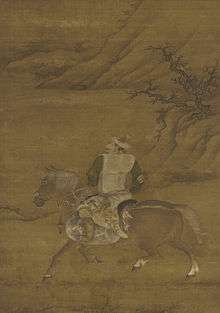
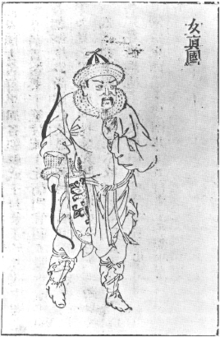
Chinese chroniclers of the Ming dynasty distinguished three different groups of Jurchens: the Wild Jurchens (野人女真; yěrén Nǚzhēn) of Outer Manchuria, the Haixi Jurchens (海西女真) of modern Heilongjiang Province and the Jianzhou Jurchens of modern Jilin Province. They led a pastoral-agrarian lifestyle, hunting, fishing, and engaging in limited agriculture. In 1388, the Hongwu Emperor dispatched a mission to establish contact with the Odoli, Huligai and T'owen tribes.
The issue of controlling the Jurchens was a point of contention between Joseon Korea and the early Ming.[28]
The Yongle Emperor (r. 1402–1424) found allies among the various Jurchen tribes against the Mongols. He bestowed titles and surnames to various Jurchen chiefs and expected them to send periodic tribute. One of the Yongle Emperor's consorts was a Jurchen princess, which resulted in some of the eunuchs serving him being of Jurchen origin.[29] Chinese commanderies were established over tribal military units under their own hereditary tribal leaders. In the Yongle period, 178 commanderies were set up in Manchuria. Later on, horse markets were established in the northern border towns of Liaodong. Increased contact with the Chinese gave Jurchens the more complex and sophisticated organizational structures.
The Koreans dealt with the Jurchen military through appeals to material benefits and launching punitive expeditions. To appease them the Joseon court handed out titles and degrees, trading with them, and sought to acculturate them by having Korean women marry Jurchens and integrating them into Korean culture. These measures were unsuccessful and fighting continued between the Jurchen and the Koreans.[30][31] This relationship between the Jurchens and Koreans was ended by the Ming which envisioned the Jurchens as a form of protective border to the north.[32] In 1403, Ahacu, chieftain of Huligai, paid tribute to the Yongle Emperor. Soon after that, Mentemu, chieftain of Odoli clan of the Jianzhou Jurchens, defected from paying tribute to Korea, becoming a tributary to China instead. Yi Seong-gye, the first ruler of Joseon, asked the Ming dynasty to send Mentemu back but was refused.[33] The Yongle Emperor was determined to wrest the Jurchens out of Korean influence and have China dominate them instead.[34][35] The Koreans tried to persuade Mentemu to reject the Ming dynasty's overtures but were unsuccessful.[36][37][38][39] The Jurchen tribes presented tribute to the Ming dynasty in succession.[40] They were divided in 384 guards by the Ming dynasty[32] and the Jurchen became vassals to the Ming emperors.[41] The name given to the Jurchen land by the Ming dynasty was Nurgan. Later, a Korean army led by Yi-Il and Yi Sun-sin would expel them from Korea.
In 1409, the Ming government created the Nurgan Command Post (奴兒干都司) at Telin (present-day Tyr, Russia,[42] about 100 km upstream from Nikolayevsk-on-Amur in the Russian Far East) in the vicinity of Heilongjiang. The Jurchens came under the nominal administration of the Nurgan Command Post which lasted only 25 years and was abolished in 1434. Leaders of the Haixi and Jianzhou tribes did however accept the Ming titles.
From 1411 to 1433, the Ming eunuch Yishiha (who himself was a Haixi Jurchen[43]) led ten large missions to win over the allegiance of the Jurchen tribes along the Songhua River and Amur River. His fleet sailed down the Songhua into the Amur, and set up the Nurgan Command at Telin near the mouth of the Amur River. These missions are not well recorded in the Ming histories, but there exist two stone steles erected by Yishiha at the site of the Yongning Temple, a Guanyin temple commissioned by him at Telin.[44] The inscriptions on the steles are in four languages: Chinese, Jurchen, Mongol, and Tibetan. There is probably quite a lot of propaganda in the inscriptions, but they give a detailed record of the Ming court's efforts to assert suzerainty over the Jurchen. When Yishiha visited Nurgan for the 3rd time in 1413, he built a temple called Yongning Temple at Telin and erected the Yongning Temple Stele in front of it. Yishiha paid his 10th visit to Nurgan in 1432, during which he rebuilt the Yongning Temple and re-erected a stele in front of it. The stele bore the heading "Record of Re-building Yongning Temple". The setting up of the Nurgan Command Post and the repeated declarations to offer blessings to this region by Yishiha and others were all recorded in this and the first steles.
In the ninth year of the Ming Xuande emperor the Jurchens in Manchuria under Ming rule suffered from famine forcing them to sell their daughters into slavery and moving to Liaodong to beg for help and relief from the Ming dynasty government.[45][46][47]
Establishment of the Manchu
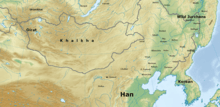
Over a period of 30 years from 1586, Nurhaci, a chieftain of the Jianzhou Jurchens, united the Jurchen tribes. In 1635, his son and successor, Hong Taiji, renamed his people the Manchus as a clear break from their past as Chinese vassals.[48][49][50] During the Ming dynasty, the Koreans of Joseon referred to the Jurchen inhabited lands north of the Korean peninsula, above the rivers Yalu and Tumen as part of the "superior country" (sangguk) which they called Ming China.[51] The Qing deliberately excluded references and information that showed the Jurchens (Manchus) as subservient to the Ming dynasty, when composing the History of Ming to hide their former subservient relationship. The Veritable Records of Ming were not used to source content on Jurchens during Ming rule in the History of Ming because of this.[52] The Yongzheng Emperor attempted to rewrite the historical record and claim that the Aisin Gioro were never subjects of past dynasties and empires trying to cast Nurhaci's acceptance of Ming titles like Dragon Tiger General (longhu jiangjun 龍虎將軍) by claiming he accepted to "please Heaven".[53]
During the Qing dynasty, the two original editions of the books of the "Qing Taizu Wu Huangdi Shilu" and the "Manzhou Shilu Tu" (Taizu Shilu Tu) were kept in the palace, forbidden from public view because they showed that the Manchu Aisin Gioro family had been ruled by the Ming dynasty.[54][55]
Our gurun (tribe, state) originally had the names Manju, Hada, Ula, Yehe, and Hoifa. Formerly ignorant persons have frequently called [us] jušen. The term jušen refers to the Coo Mergen of Sibe barbarians and has nothing to do with our gurun. Our gurun establishes the name Manju. Its rule will be long and transmitted over many generations. Henceforth persons should call our gurun its original name, Manju, and not use the previous demeaning name.
Culture

Jurchen culture shared many similarities with the hunter-gatherer lifestyle of Siberian-Manchurian tundra and coastal peoples. Like the Khitans and Mongols, they took pride in feats of strength, horsemanship, archery, and hunting. Both Mongols and Jurchens used the title Khan for the leaders of a political entity, whether "emperor" or "chief". A particularly powerful chief was called beile ("prince, nobleman"), corresponding with the Mongolian beki and Turkish beg or bey. Also like the Mongols and the Turks, the Jurchens did not observe primogeniture. According to tradition, any capable son or nephew could be chosen to become leader.
Unlike the Mongols,[56][57] the Jurchens were a sedentary[58][13] and agrarian society. They farmed grain and millet as their primary cereal crops, grew flax and raised oxen, pigs, sheep, and horses.[59] "At the most", the Jurchen could only be described as "semi-nomadic" while the majority of them were sedentary.[25]
Jurchen similarities and differences with the Mongols were emphasized to various degrees by Nurhaci out of political expediency.[60] Nurhaci once said to the Mongols that "the languages of the Chinese and Koreans are different, but their clothing and way of life is the same. It is the same with us Manchus (Jušen) and Mongols. Our languages are different, but our clothing and way of life is the same." Later, Nurhaci indicated that the bond with the Mongols was not based on any real shared culture, but rather on pragmatic reasons of "mutual opportunism". He said to the Mongols, "You Mongols raise livestock, eat meat and wear pelts. My people till the fields and live on grain. We two are not one country and we have different languages".[61]
During the Ming dynasty, the Jurchens lived in sub-clans (mukun or hala mukun) of ancient clans (hala). Not all clan members were blood related, and division and integration of different clans was common. Jurchen households (boo) lived as families (booigon) consisting of five to seven blood-related family members and a number of slaves. Households formed squads (tatan) to engage in tasks related to hunting and food gathering and formed companies (niru) for larger activities, such as war.
Haixi, Jianzhou, Yeren
The Haixi Jurchens were "semi-agricultural, the Jianzhou Jurchens and Maolian (毛怜) Jurchens were sedentary, while hunting and fishing was the way of life of the "Wild Jurchens".[62] Hunting, horseback archery, horsemanship, livestock raising, and sedentary agriculture were all practiced by Jianzhou Jurchens.[63] The Jurchen way of life (economy) was described as agricultural. They farmed crops and raised animals.[64] Jurchens practiced slash-and-burn agriculture in the areas north of Shenyang.[65]
“建州毛憐則渤海大氏遺孽,樂住種,善緝紡,飲食服用,皆如華人,自長白山迤南,可拊而治也。" "The (people of) Chien-chou and Mao-lin [YLSL always reads Mao-lien] are the descendants of the family Ta of Balhae. They love to be sedentary and sow, and they are skilled in spinning and weaving. As for food, clothing and utensils, they are the same as (those used by) the Chinese. (Those living) south of the Ch'ang-pai mountain are apt to be soothed and governed."
Pigtail
In 1126, the Jurchens initially ordered male Han Chinese within their conquered territories to adopt the Jurchen hairstyle by shaving the front of their heads and adopting Jurchen dress, but the order was later lifted.[68] Jurchens were impersonated by Han rebels who wore their hair in the Jurchen "pigtail" to strike fear within their population.[69] During the Qing dynasty, the Manchus, who descended from the Jurchens, similarly made Han Chinese men shave the front of their head and wear the rest of their hair in a queue, or soncoho (辮子; biànzi), the traditional Manchu hairstyle.
Dogs
Although their Mohe ancestors did not respect dogs, the Jurchens began to respect dogs around the time of the Ming dynasty and passed this tradition on to the Manchus. It was prohibited in Jurchen culture to use dog skin, and forbidden for Jurchens to harm, kill, or eat dogs. The Jurchens believed that the "utmost evil" was the usage of dog skin by Koreans.[70]
Burial
Until recently, it was uncertain what kind of burial rites existed among the Jurchens. In July 2012, Russian archaeologists discovered a Jurchen burial ground in Partizansky District of Primorye in Russia. Fifteen graves dating to the 12th or 13th centuries were found, consisting of the grave of a chieftain placed in the centre, with the graves of 14 servants nearby. All the graves contained pots with ashes, prompting the scientists to conclude that the Jurchens cremated the corpses of their dead. The grave of the chieftain also contained a quiver with arrows and a bent sword. The archaeologists propose that the sword was purposely bent, to signify that the owner would no longer need it in earthly life. The researchers planned to return to Primorye to establish whether this was a singular burial or a part of the larger burial ground.[71]
Religion
Jurchens practiced shamanic rituals and believed in a supreme sky goddess (abka hehe, literally sky woman). The Jurchens of the Jin dynasty practiced Buddhism, which became the prevalent religion of the Jurchens, and Daoism.[72] Under Confucian influence during the Qing dynasty the gender of the female sky deity was switched to a male sky father, Abka Enduri (abka-i enduri, abka-i han).[73]
Language
The early Jurchen script was invented in 1120 by Wanyan Xiyin, acting on the orders of Wanyan Aguda. It was based on the Khitan script that was inspired in turn by Chinese characters. The written Jurchen language died out soon after the fall of the Jin dynasty. The Translators' Bureau of the Ming tributary bureaucracy received a communication from the Jurchens in 1444 stating that nobody among them understood the Jurchen script, so all letters sent to them should be written in Mongolian.[74]
Until the end of the 16th century, when Manchu became the new literary language, the Jurchens used a combination of Mongolian and Chinese. The pioneering work on studies of the Jurchen script was done by Wilhelm Grube at the end of the 19th century.
See also
- Ethnic groups in Chinese history
- Korean-Jurchen wars
- List of Chieftains of the Jurchens
- Nani people
- Toi invasion
Notes
References
Citations
- Grand Dictionnaire Ricci de la Langue Chinoise, Vol. IV, Paris: Institut Ricci, 2001, p. 697. (in French) & (in Chinese)
- 遼朝國號非「哈喇契丹(遼契丹)」考 Archived 27 September 2011 at the Wayback Machine
- Hoong 2005, p. 28
- Roth Li, Gertraude (2002). J. Peterson, William (ed.). 'State Building Before 1644'. The Cambridge History of China, vol. 9 part 2. United States of America: Cambridge University Press. pp. 11–13. ISBN 0-521-24334-3.
- Roth Li, Gertraude (2002). J. Peterson, William (ed.). 'State Building Before 1644'. The Cambridge History of China, vol. 9 part 1. Cambridge: Cambridge University Press. p. 27. ISBN 0-521-24334-3.
- Franke (1994), p. 216.
- Aisin Gioro & Jin 2007, p. 12.
- Pelliot (1959), p. 366.
- Pelliot (1959), p. 367.
- Baxter-Sagart.
- 《汲冢周书》.
- Janhunen 2004, pp. 67 ff.
- Vajda 2000.
- Stolberg 2015.
- Kane 1997, p. 232.
- Elliott 2001, p. 51.
- Rockhill 1967, p. 153.
- Crossley 1997, p. 46.
- Elliott 2001, p. 47–48.
- Huang 1990, pp. 239–282.
- Elliott 2001, p. 47.
- Elliott 2001, p. 48.
- Gorelova 2002, pp. 13–14.
- Crossley 1997, p. 17.
- Breuker 2010, pp. 220–221.
- Tillman, Hoyt Cleveland (1995). Tillman, Hoyt Cleveland; West, Stephen H. (eds.). China Under Jurchen Rule: Essays on Chin Intellectual and Cultural History (illustrated ed.). SUNY Press. p. 27. ISBN 0791422739.
- Mote 1999, p. 195.
- Wang 2010, p. 301.
- Mitamura 1970, p. 54.
- Seth 2006, p. 138.
- Seth 2010, p. 144.
- Peterson 2006, p. 15
- Meng 2006, p. 120
- Zhang 2008, p. 29.
- Dardess 2012, p. 18.
- Goodrich 1976, p. 1066.
- Peterson 2002, p. 13.
- Clark 1998, pp. 286-7.
- Zhang 2008, p. 30.
- Meng 2006, p. 21
- Cosmo 2007, p. 3.
- Объекты туризма — Археологические. Тырские храмы Archived 3 September 2009 at the Wayback Machine (Regional government site explaining the location of the Tyr (Telin) temples: just south of the Tyr village) (in Russian)
- Shih-Shan Henry Tsai, "Perpetual Happiness: The Ming Emperor Yongle". Published by University of Washington Press, 2002. ISBN 0295981245 Partial text on Google Books. p. 158.
- Telin Stele (from: "Политика Минской империи в отношении чжурчженей (1402 -1413 гг.)" (The Jurchen policy of the Ming Empire), in "Китай и его соседи в древности и средневековье" (China and its neighbors in antiquity and the Middle Ages), Moscow, 1970. (in Russian)
- https://www.itsfun.com.tw/%E4%BA%A6%E5%A4%B1%E5%93%88/wiki-3774856-0311736 亦失哈 宣德九年,女真地区灾荒,女真人被迫卖儿鬻女,四处流亡,逃向辽东的女真难民,希望得到官府的赈济。
- http://hlj.ifeng.com/culture/history/detail_2014_07/08/2559681_0.shtml 亦失哈
- https://baike.baidu.com/item/%E4%BA%A6%E5%A4%B1%E5%93%88 亦失哈
- Hummel, Arthur W., ed. (2010). "Abahai". Eminent Chinese of the Ch'ing Period, 1644–1912 (2 vols) (reprint ed.). Global Oriental. p. 2. ISBN 978-9004218017. Via Dartmouth.edu
- Grossnick, Roy A. (1972). Early Manchu Recruitment of Chinese Scholar-officials. University of Wisconsin—Madison. p. 10.
- Till, Barry (2004). The Manchu era (1644–1912): arts of China's last imperial dynasty. Art Gallery of Greater Victoria. p. 5.
- Kim, Sun Joo (2011). The Northern Region of Korea: History, Identity, and Culture. University of Washington Press. p. 19. ISBN 978-0295802176.
- Smith, Richard J. (2015). The Qing Dynasty and Traditional Chinese Culture. Rowman & Littlefield. p. 216. ISBN 978-1442221949.
- Crossley, Pamela Kyle (2002). A Translucent Mirror: History and Identity in Qing Imperial Ideology (illustrated, reprint ed.). University of California Press. pp. 303–4. ISBN 0520234243.
- Hummel, Arthur W., ed. (2010). "Nurhaci". Eminent Chinese of the Ch'ing Period, 1644–1912 (2 vols) (reprint ed.). Global Oriental. p. 598. ISBN 978-9004218017. Via Dartmouth.edu
- The Augustan, Volumes 17-20. Augustan Society. 1975. p. 34.
- Franke 1994, p. 217.
- Rachewiltz 1993, p. 112.
- Williamson 2011.
- Franke 1990, p. 416.
- Perdue 2009, p. 127.
- Peterson 2002, p. 31.
- Chan 1988, p. 266.
- Rawski 1996, p. 834.
- Wurm, Mühlhäusler & Tyron 1996, p. 828.
- Reardon-Anderson 2000, p. 504.
- 萧国亮 (24 January 2007). "明代汉族与女真族的马市贸易". 艺术中国(ARTX.cn). p. 1. Retrieved 25 July 2014.
- Serruys 1955, p. 22.
- Zhang 1984, pp. 97–8.
- Franke 1990, p. 417.
- Aisin Gioro & Jin 2007, p. 18.
- "A Large Burial Ground of the Jurchen People Has Been Found In Russia's Primorye :: Russia-InfoCentre". Russia-ic.com. 27 July 2012. Retrieved 17 August 2012.
- Ulrich Theobald. "Chinese History – Jin Dynasty (Jurchen) 金 religion and customs". www.chinaknowledge.de. Retrieved 17 August 2012.
- Judika Illes, Encyclopedia of Spirits: The Ultimate Guide to the Magic of Fairies, Genies, Demons, Ghosts, Gods & Goddesses (2009)
- Crossley 1997, p. 38.
Sources
- Aisin Gioro, Ulhicun; Jin, Shi (2007), "Manchuria from the Fall of the Yuan to the Rise of the Manchu State (1368–1636)" (PDF), Ritsumeikan Bungaku, pp. 12–34
- Arnold, Lauren (1999), Mark Stephen Mir (ed.), Princely Gifts and Papal Treasures: The Franciscan Mission to China and Its Influence on the Art of the West, 1250–1350, Desiderata Press, p. p. 179, ISBN 9780967062808
- Association for Asian Studies. Ming Biographical History Project Committee (1976), Goodrich, Luther Carrington (ed.), Dictionary of Ming Biography, 1368-1644, 2 (illustrated ed.), Columbia University Press, p. 1066, ISBN 023103833X
- Bretschneider, E. (2013), "Pei Shi Ki", Mediaeval Researches from Eastern Asiatic Sources: Fragments towards the Knowledge of the Geography and History of Central and Western Asia from the 13th to the 17th Century, Vol. I, London: Routledge, Trench, Trübner, & Co., p. 25, ISBN 9781136380211
- Breuker, Remco E. (2010), Establishing a Pluralist Society in Medieval Korea, 918-1170: History, Ideology and Identity in the Koryŏ Dynasty, Volume 1 of Brill's Korean Studies Library, Leiden: Brill, pp. 220-221, ISBN 978-9004183254
- Chan Hok-lam (1988), "The Chien-wen, Yung-lo, Hung-hsi, and Hsüan-te Reigns, 1399–1435", in Frederick W. Mote; Denis Twitchett; John K. Fairbank (eds.), The Cambridge History of China, Vol. 7: The Ming Dynasty, 1368–1644, Pt. 1, Cambridge: Cambridge University Press, pp. 182–304, ISBN 0521243327
- Clark, Donald N. (1998), "Sino-Korean Tributary Relations under the Ming", in Denis C. Twitchett; Frederick W. Mote (eds.), The Cambridge History of China, Vol. 8: The Ming Dynasty, 1368–1644, Pt. 2, England: Cambridge University Press, pp. 272–300, ISBN 0521243335
- Cosmo, Nicola Di (2007), The Diary of a Manchu Soldier in Seventeenth-Century China: "My Service in the Army", by Dzengseo, Volume 3 of Routledge Studies in the Early History of Asia (annotated ed.), Routledge, p. 3, ISBN 978-1135789558
- Crossley, Pamela Kyle (1997), The Manchus, Blackwell Publishers Ltd
- Dardess, John W. (2012), Ming China, 1368–1644: A Concise History of a Resilient Empire, Rowman & Littlefield, p. 18, ISBN 978-1-4422-0490-4
- Elliott, Mark C. (2001), The Manchu Way: The Eight Banners and Ethnic Identity in Late Imperial China (illustrated, reprint ed.), Stanford University Press, ISBN 0804746842
- Fox, Ralph (1936), Genghis Khan, Harcourt & Brace, p. 278
- Franke, Herbert (1990), "The Forest Peoples of Manchuria: Kitans and Jurchens", in Denis Sinor (ed.), The Cambridge History of Early Inner Asia, Vol. I, Cambridge: Cambridge University Press, pp. 400–423, ISBN 9780521243049
- Franke, Herbert (1994), "The Chin Dynasty", in Twitchett, Denis C.; Franke, Herbert (eds.), The Cambridge History of China, Vol. 6: Alien Regimes and Border States, 907–1368, Cambridge: Cambridge University Press, pp. 215–320, ISBN 9780521243315
- Gernet, Jacques (1972), Le Monde Chinois [A History of Chinese Civilization], Cambridge: translated by J.R. Foster and Charles Hartman for Cambridge University Press in 1982, p. 356, ISBN 9780521497817
- Gorelova, Liliya M., ed. (2002), Handbook of Oriental Studies. Section 8 Uralic & Central Asian Studies, Manchu Grammar, Volume Seven Manchu Grammar, Brill Academic Pub, pp. 13–14, ISBN 9004123075
- Hoong Teik Toh (2005), Martin Gimm; Giovanni Stary; Michael Weiers (eds.), Materials for a Geneaology of the Niohuru Clan with Introductory Remarks on Manchu Onomastics, Aetas Manjurica, No. 10, Wiesbaden: Otto Harrassowitz KG, p. 28, ISBN 9783447051965
- Howorth, H.H. (October 1871), "The Origines of the Manchus", in James Summers (ed.), The Phœnix: A Monthly Magazine for India, Burma, Siam, China, Japan, & Eastern Asia, Vol. II, No. 16, London, p. 53
- Huang Pei (1990), "New Light on the Origins of the Manchu", Harvard Journal of Asiatic Studies, 50, pp. 239–282
- Huttman, William (1843), "An Account of Peking", Fisher's Colonial Magazine and Commercial Maritime Journal, Vol. II, London: Fisher, Son, & Co., p. 178
- Janhunen, Juha (2004), "From Choson to Jucher: On the Possibilities of Ethnonymic Continuity in Greater Manchuria", in Marek Stachowski; Kinga Maciuszak (eds.), Studia Etymologica Cracoviensia, Vol. 9 (PDF), Krakow: Jagiellonian University Press, pp. 67 ff
- Kane, Daniel (1997), "Language Death and Language Revivalism: The Case of Manchu", Central Asiatic Journal, 41, pp. 231–249
- Keane, Augustus Henry; Quiggin, A. Hingston; Haddon, A.C. (1920), Man: Past and Present, Cambridge: Cambridge University Press, p. 279, ISBN 9780521234108
- Lach, Donald F.; Kley, Edwin J. Van (1998), Asia in the Making of Europe, Vol. III, p. 1760
- Meng, Sen (2006), 《满洲开国史讲义》 [Lecture Notes on Early Manchu History], Zhonghua Book Co., ISBN 7101050301
- Mitamura, Taisuke (1970), Chinese eunuchs: the structure of intimate politics, C.E. Tuttle Co., p. 54
- Morgan, E. Delmar (1872), "An Expedition through Manchuria, from Pekin to Blagovestchensk, in 1870, by the Archimandrite Palladius, Chief of the Russo-Greek Church Mission at Pekin", The Journal of the Royal Geographical Society, Vol. XLII, London: William Clowes & Sons for John Murray, p. 159
- Morrison, Robert (1815–1823), A Dictionary of the Chinese Language in Three Parts, Macao: East India Company’s Press
- Morrison (1819), Dictionary, Pt. II, Vol. I, p. xvii–xviii
- Mote, Frederick (1999), Imperial China, 900–1800, Harvard University Press, p. 195
- Muto, Tomio (1939), Pan-Pacific, Pan-Pacific Union, pp. 113–114
- Pelliot, Paul (1959), Notes on Marco Polo, Vol. I, Paris: Imprimerie Nationale, §161: Ciorcia
- Perdue, Peter C (2009), China Marches West: The Qing Conquest of Central Eurasia (reprint ed.), Harvard University Press, p. 127, ISBN 978-0674042025, retrieved 10 March 2014
- Peterson, Willard J., ed. (2002), The Cambridge History of China, Vol. 9, Pt. 1: The Ch'ing Dynasty to 1800, Cambridge: Cambridge University Press, pp. 13, 31, ISBN 0-521-24334-3
- Rachewiltz, Igor De, ed. (1993), In the Service of the Khan: Eminent Personalities of the Early Mongol-Yüan Period (1200–1300), Volume 121 of Asiatische Forschungen, Otto Harrassowitz Verlag, p. 112, ISBN 3447033398, ISSN 0571-320X, retrieved 10 March 2014
- Ravenstein, Ernest George; Keane, Augustus Henry, eds. (1882), The Universal Geography, Vol. VII, J.S. Virtue & Co., p. 121
- Rawski, Evelyn S. (November 1996), "Presidential Address: Reenvisioning the Qing: The Significance of the Qing Period in Chinese History", The Journal of Asian Studies, Association for Asian Studies, 55 (4): 829–850, doi:10.2307/2646525, JSTOR 2646525
- Rawski, Evelyn S. (15 November 1998), The Last Emperors: A Social History of Qing Imperial Institutions, University of California Press, p. 43, ISBN 978-0-520-92679-0
- Reardon-Anderson, James (October 2000), "Land Use and Society in Manchuria and Inner Mongolia during the Qing Dynasty", Environmental History, Forest History Society and American Society for Environmental History, 5 (4): 503–530, doi:10.2307/3985584, JSTOR 3985584
- Rockhill, William Woodville (1967), The Journey of William of Rubruck to The Eastern Parts of the World, 1253-55, As Narrated by Himself, With Two Accounts of the Earlier Journey of John of Pian de Carpine.
- Ross, John (1891), The Manchus, or, The Reigning Dynasty of China: Their Rise and Progress, London: Elliot Stock, p. 76
- Rossabi, Morris (1998), "The Ming and Inner Asia", in Denis C. Twitchett; Frederick W. Mote (eds.), The Cambridge History of China, Vol. 8: The Ming Dynasty, 1368–1644, Pt. 2, England: Cambridge University Press, pp. 221–71, ISBN 0521243335
- Seth, Michael J. (2006), A Concise History of Korea: From the Neolithic Period Through the Nineteenth Century, Rowman & Littlefield, p. 138, ISBN 978-0-7425-4005-7
- Seth, Michael J. (16 October 2010), A History of Korea: From Antiquity to the Present, Rowman & Littlefield Publishers, p. 144, ISBN 978-0-7425-6717-7
- Stolberg, Eva M. (2015), "Tungusic", in Steven Danver (ed.), Native Peoples of the World: An Encyclopedia of Groups, Cultures, and Contemporary Issues, Abingdon: Routledge, pp. 713–714, ISBN 9781317463993
- Serruys, Henry (1955), Sino-J̌ürčed relations during the Yung-Lo period, 1403–1424, Volume 4 of Göttinger asiatische Forschungen, O. Harrassowitz, p. 22, ISBN 0742540057
- Vajda, Edward J. (2000), "Manchu (Jurchen)", East Asian Studies 210: Introduction to Nomadic Cultures, Western Washington University, retrieved 16 February 2014
- Wylie, Alexander (1855), Translation of the Ts'ing Wan K'e Mung, A Chinese Grammar of the Manchu Tartar Language, with Introductory Notes on Manchu Literature, Shanghai: London Mission Press, p. lxxvi
- Wang, Yuan-kang (6 December 2010), Harmony and War: Confucian Culture and Chinese Power Politics, Columbia University Press, p. 301, ISBN 978-0-231-52240-3
- Wei Cuiyi Wei Ts'ui-i; Karl W. Luckert (1998), Uighur Stories from along the Silk Road, University Press of America, p. 91
- Williams, Henry Smith (1904), The Historians' History of the World: Poland, The Balkans, Turkey, Minor Eastern States, China, Japan, Outlook Company, p. 272
- Wittfogel, Karl August; Fêng, Chia-shêng (March 1946), History of Chinese Society: Liao, 907–1125, Transactions of the American Philosophical Society, 36, American Philosophical Society, p. 10, ISBN 978-1-4223-7719-2
- Wylie, Alexander (1860), "On an Ancient Inscription in the Neu-chih Language", Journal of the Royal Asiatic Society of Great Britain and Ireland, Vol. XVII, London: John W. Parker & Son, pp. 331–345

- Yule, Henry (1911), , in Chisholm, Hugh (ed.), Encyclopædia Britannica, 6 (11th ed.), Cambridge University Press, p. 189
- Zhang Boquan (1984), 《金史简编》, Liaoning People's Publishing, pp. 97–98
- Zhang Feng (2008), "Traditional East Asian Structure from the Perspective of Sino-Korean Relations", International Relations Department The London School of Economics and Political Science: 29, 30, archived from the original on 20 April 2014, retrieved 18 April 2014,
Paper presented to ISA’s 49th Annual Convention, San Francisco, March 26–29, 2008
Cite journal requires|journal=(help)
Further reading
- Wurm, Stephen Adolphe; Mühlhäusler, Peter; Tyron, Darrell T., eds. (1996), Atlas of Languages of Intercultural Communication in the Pacific, Asia, and the Americas, 1, International Council for Philosophy and Humanistic Studies, Walter de Gruyter, p. 828, ISBN 3110134179
External links
- Jurchen script
- (in Chinese) The Jurchen language and Script Website (Chinese Traditional Big5 code page) via Internet Archive
- The Russian news about the discovery of the Jurchen burial ground, July 2012
